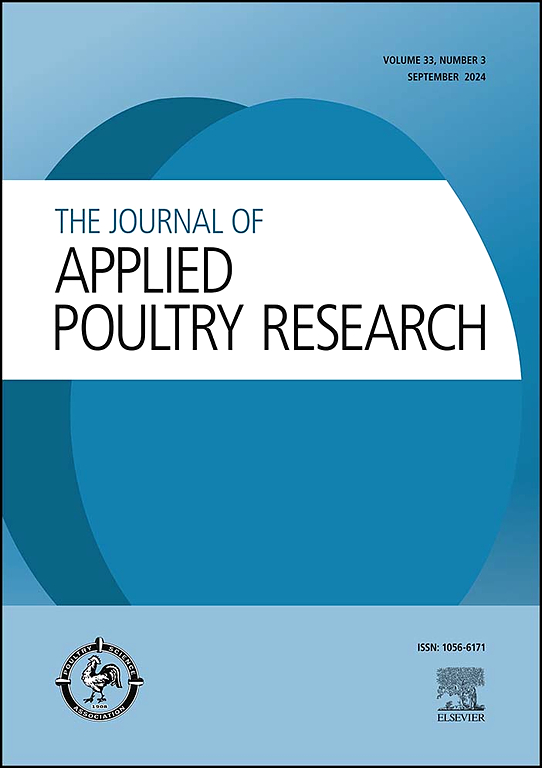Probiotic post feed restriction supplementation on realimentation performances, carcass characteristic, gut morphology and gut microbes of broiler chicken
IF 2
3区 农林科学
Q2 AGRICULTURE, DAIRY & ANIMAL SCIENCE
引用次数: 0
Abstract
This study investigated the impact of probiotic (Protexin) supplementation on growth performance, economic cost, and carcass components of broiler chickens during compensatory growth following feed restriction. A total of 384 one-day-old male broiler chicks (Arian) were randomly assigned to four treatment groups with 6 replicate cages and 16 broiler chickens per cage. The treatment structure followed a 2 × 2 factorial arrangement with the main factors being feed restriction (without restriction and 15% restriction) from days 10 to 18 and two subgroups of feeding (no additive and probiotic) from days 18 to 42. Results showed no interactive effects of general performance observed in all. Birds on the probiotic supplementation (PS) diet had significantly higher weight and greater weight gain (WG) in the post-restriction period (days 18-42). Feed efficiency of birds from days 18 to 42 was lower in birds with restricted access to feed from days 10-18 of age. Apart from abdominal fat, which was decreased by FR and PS, no other carcass components or organ weights were affected by the treatments. The ileal microbiota of the broilers was affected by feed restriction at the end of the restriction period (day 18) and PS reduced E. coli and increased Lactobacillus by day 42. Villus height increased in both jejunum and ileum with PS (P > 0.05). Feed restriction and PS supported the performance of broiler chickens during realimentation; however, the interactive effects of those are not significant under the current conditions.
饲后限饲益生菌对肉鸡生产性能、胴体特性、肠道形态和肠道微生物的影响
本研究旨在探讨饲粮限制后补偿性生长期间,添加益生菌(蛋白蛋白)对肉鸡生长性能、经济成本和胴体成分的影响。选取1日龄雄性肉仔鸡384只,随机分为4个处理组,每组6个重复笼,每个笼16只鸡。试验采用2 × 2因子处理结构,其中第10 ~ 18天饲喂限饲(无限饲和15%限饲),第18 ~ 42天饲喂两个亚组(无添加剂和益生菌)。结果显示,在所有实验中均未观察到总体表现的交互影响。饲粮中添加益生菌(PS)的雏鸟在限制期后(第18-42天)体重显著增加,增重显著增加。在10-18日龄限制饲喂的雏鸟中,18 - 42日龄雏鸟的饲料效率较低。除FR和PS降低了腹部脂肪外,其他胴体成分和器官重量均未受影响。限饲期结束时(第18天),肉仔鸡回肠菌群受到影响,第42天,PS降低了大肠杆菌,增加了乳酸杆菌。PS使空肠和回肠绒毛高度增加(P >;0.05)。饲限和PS支持肉仔鸡育肥期生产性能;然而,在目前的条件下,这些相互作用的影响并不显著。
本文章由计算机程序翻译,如有差异,请以英文原文为准。
求助全文
约1分钟内获得全文
求助全文
来源期刊

Journal of Applied Poultry Research
农林科学-奶制品与动物科学
CiteScore
4.10
自引率
10.50%
发文量
80
审稿时长
104 days
期刊介绍:
The Journal of Applied Poultry Research (JAPR) publishes original research reports, field reports, and reviews on breeding, hatching, health and disease, layer management, meat bird processing and products, meat bird management, microbiology, food safety, nutrition, environment, sanitation, welfare, and economics. As of January 2020, JAPR will become an Open Access journal with no subscription charges, meaning authors who publish here can make their research immediately, permanently, and freely accessible worldwide while retaining copyright to their work. Papers submitted for publication after October 1, 2019 will be published as Open Access papers.
The readers of JAPR are in education, extension, industry, and government, including research, teaching, administration, veterinary medicine, management, production, quality assurance, product development, and technical services. Nutritionists, breeder flock supervisors, production managers, microbiologists, laboratory personnel, food safety and sanitation managers, poultry processing managers, feed manufacturers, and egg producers use JAPR to keep up with current applied poultry research.
 求助内容:
求助内容: 应助结果提醒方式:
应助结果提醒方式:


